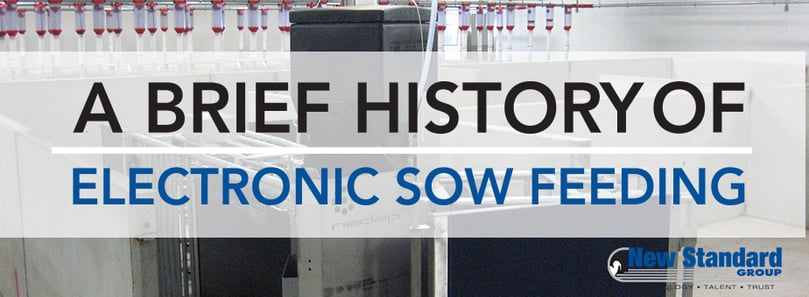
Due to both consumer pressures and the need for improved barn efficiency and reduced feed costs, pork producers in North America are moving towards Electronic Sow Feeding in hog barns. Nedap's automated sow feeding technology has been around since the early 1980s and has since developed into a complete sow management system. Learn more about the evolution of ESF technology from dysfunctional identification collars to fully automated barn management systems.
From Cows to Sows
Before Electronic Sow Feeding systems, livestock identification systems were mainly used in dairy production. The Dutch specialized in these identification systems and decided to test them in swine production. They copied this identification technology over to group sow housing in the early 1980s and developed the first systems using the same strategies and equipment used to keep track of cows. Nedap, who is the ESF industry leader and expert today, built their first system (called Porcode) based on the already developed Cattle Code equipment that they built in 1972. Nedap tested these initial systems on their own test farm of about 150 sows, and they continued using the test farm until the mid-1990s. While these systems do create a better environment for the pigs, they were not originally designed to tackle animal welfare issues. The focus was to move the proven precision farming practices over from dairy farming to be able to provide sows with the exact amount of feed they need to reduce unnecessary feed costs.
Learning Curve in the 1980s
The first phase of Electronic Sow Feeding design was focused on creating reliable equipment and systems. From 1982, when identification systems were first introduced to sows, to 1989, ESF designers faced a steep learning curve. The original systems were undeniably flawed. One of the major issues was with the identification neck collars that each sow wore. Unlike cows, pigs' necks are about the same size (or larger) around as their head, so they were often able to slip the collars off. There was about a 40% collar loss rate with these systems. This created a whole bunch of problems; some sows weren't being feed and others were being overfed. How would they be overfed you ask? Pigs are extremely intelligent animals, and they learned quickly how to grab the lost identifying collars in their mouth and take them to the feeders where they would receive an extra ration of food.
The 1990s and 2000s
Development in the 1990s
Towards the end of the 80s and in the early 90s, the systems started to evolve into functional and reliable systems. The collar loss issue was taken care of when ear buttons were introduced in 1989. In 1992, the first automatic sow heat detector was developed, but for the most part, not much happened from 1990 to the late 90s because there was not much demand for the systems. That changed in 1997 when Europe decided to start phasing out stall barns. Consumer driven animal welfare was forcing everyone to become interested in ESF again. European farmers were faced with the challenge of effectively feeding sows in loose housing barns.
In this time frame, the Porcwin software for PCs was developed and central separation units started being incorporated in ESF barn designs. These automated systems were starting to develop into more than just feeding systems with increased sow tracking capabilities and the ability to incorporate other barn functions into the system.
Introduction to North America
While all this movement was happening in Europe, the trend had not caught on yet in North America. While automated sow feeding systems were designed to improve efficiency in production and cut feed costs, North American farmers did not yet see the need to switch over. The first ESF Barns started being designed in the early 2000s in Canada, but there was no real pressure to convert until 2007. In 2007, both Smithfield and Maple Leaf Foods declared that all their stall barns would be phased out and replaced with group sow housing. With this move, the interest in ESF barns immediately changed. North American producers understood that consumer pressure was starting to require them to redesign their hog barns. Like European farmers in the late 90s, they were challenged with finding feeding and organizational systems that worked well in group sow housing. Again, since these systems were originally built for production efficiency and precision feeding, they were exactly what many producers were looking for. The transition to Electronic Sow Feeding started with the remodeling of existing hog facilities and the building of new barns all over both Canada and the United States, and the transition continues today.
Complete Management System
When these systems were first built, they were designed to simply feed pigs the exact amount they needed in an efficient manner. Over time Electronic Sow Feeding has developed into a complete management system that not only feeds your sows but also tracks important data, automates sorting, weighs each sow, detects when each sow is in heat, and more. With the introduction of the Velos program in 2006, all this data has become cloud based and the systems can be controlled from an onsite computer or monitored from anywhere in the world. When designed and setup properly, ESF barns are extremely efficient and easy to use. The automation has allowed farmers to keep a constant watch on their animals to determine when anything is even the slightest bit off in the barn.
Timeline of Major ESF Events
1974 - Nedap started with Cattle Systems (Cattle Code)
1982 - Identification systems were introduced to sows (Porcode)
1983/1984 - Nedap started using cow feedstations for pigs where pigs had to go in and back out when they were finished (Later systems were changed to a walktrough system which was already a step to success)
1989 - Ear buttons replaced identification collars
1992 - First automatic heat detector was introduced
1997 - Porcwin software for PC was developed
1998 - Central separation unit began being incorporated into hog barn designs
2000 - Leading the sows away from the feeder entrance was another big step in combination with central separation
2002 - Porcwin computer was built
2005 - Identification systems were incorporated into central separation
2006 - Velos cloud based system was introduced (can be accessed by any computers/mobile phone/other devices that have a webbrowser at the same time)
2016 – Nedap introduced sow weighing in the separation alley
If you are interested in learning more about the history of Electronic Sow Feeding and how we design Nedap equipment into group sow housing, give us a call or setup a consultation with us today.




